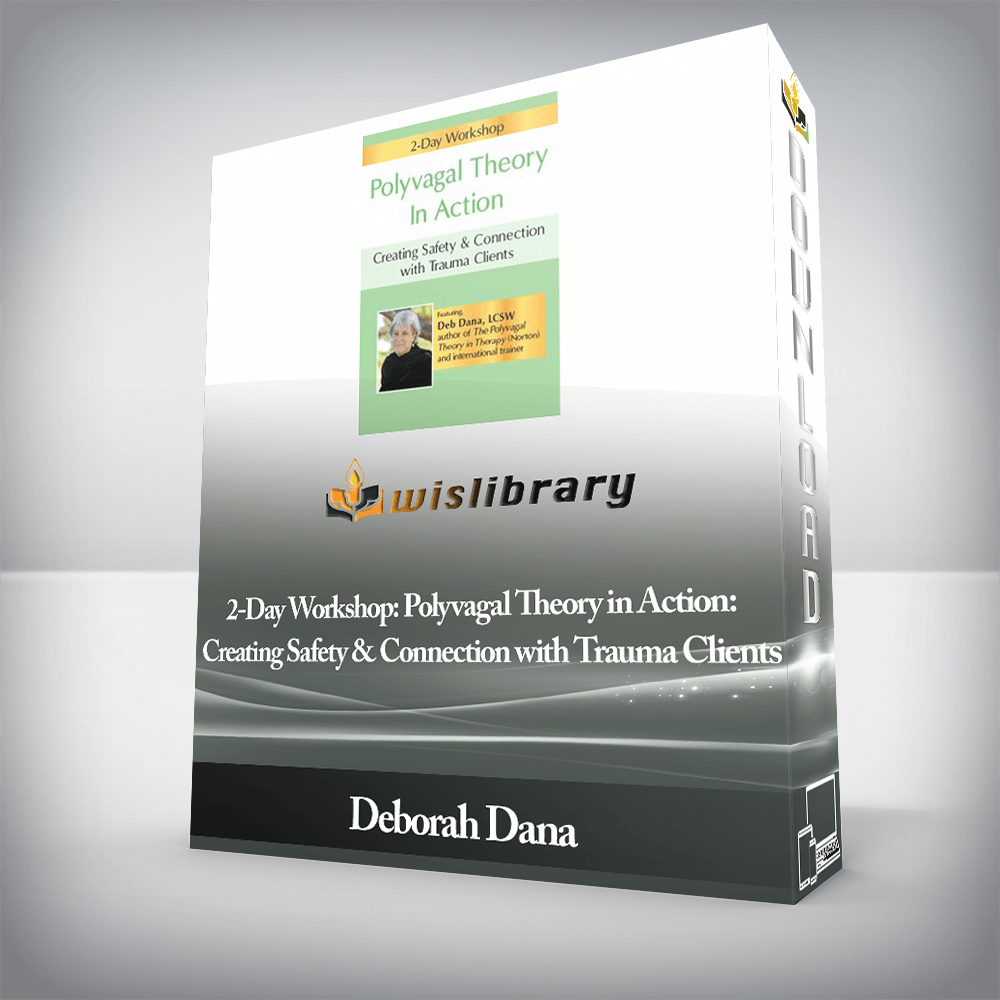Deborah Dana – PESI – 2-Day Workshop: Polyvagal Theory in Action: Creating Safety & Connection with Trauma Clients

Have you had a client who could out-think their trauma? Likely you haven’t … because trauma isn’t healed through thought.
Clients come to us looking for ways to feel safe and regulated in their daily lives – but the trauma client is often stuck in a dysregulated state.
Like us, they want to be able to navigate the normal “shifting” we do in our daily life – transitioning from one state to another. Hyper to calm, irritated to relaxed, overwhelmed to feeling in control.
In the words of author of The Polyvagal Theory in Therapy (Norton) and international trainer Deb Dana, LCSW, they are ”longing” to come into a state of regulation”.
And it’s our job to help them. It’s what we trained for, what we dreamed of doing, and where we get the deep satisfaction from the work we do.
By attending this two-day applied training, Deb will give you:
- A deep knowledge of Polyvagal Theory – in easy to understand language
- Practical ways to work with the autonomic nervous system that create connection and safety … through techniques she’s honed and will share with you
The Polyvagal approach is not a model of therapy or a protocol to follow. It is an understanding of three organizing principles around which you can create your own approach and technique, blending them with your preferred model.
The goal is that you leave the training inspired to try something new with a client – and that you have a roadmap to do so effectively.
Each client is unique, each therapist unique, and each approach unique, but using the foundation of our autonomic nervous system and working with states of engagement and dysregulation are universal ingredients for clinical success to happen. Learning Polyvagal Theory and how to apply it in your practice may become one of the most transformational moments in your career.
Increasingly, Polyvagal Theory is being discussed at conferences here and abroad, written about in articles, and taught in arenas of higher learning. Register for this training and revolutionize your practice. It is time to stop being mystified by the name “Polyvagal Theory” and realize the immediate benefits of knowing and incorporating its principles in your clinical work.
- Determine the principles of Polyvagal Theory and how to communicate them in client friendly language.
- Distinguish three circuits of the autonomic nervous system for use in client psychoeducation.
- Analyze how the autonomic nervous system operates as an internal surveillance system and its impact on clients’ habitual responses to trauma.
- Determine how to help clients engage the regulating capacities of the autonomic nervous system that create an environment of safety.
- Determine how to exercise the Social Engagement System to assist clients in becoming more adept in skills of co-regulation and creating reciprocal relationships.
- Assess for patterns in clients’ autonomic states to better inform treatment planning.
- Support the trauma-informed therapist’s role as co-regulator and its impact on clinical outcomes.
- Distinguish portals of intervention in the autonomic nervous system to more effectively establish safety and treat trauma.
- Employ the right degree of neural challenge and exercises to employ with clients to help shape the autonomic nervous system toward safety and connection.
- Evaluate how to work with the cycle or reciprocity-rupture-repair in helping clients achieve the biological need for connection.
- Design a Polyvagal-guided clinical practice based on appropriate assessment and treatment planning.
- Categorize ethical issues, research limitations, and potential risks to be considered by a Polyvagal-guided therapist.
Essentials of Polyvagal Theory
- The evolution of the autonomic nervous system
- How trauma shapes ways the body responds
- Three organizing principles of Polyvagal Theory:
- Neuroception: Detection without perception
- Hierarchy: 3 predictable pathways of response
- Coregulation: The biological imperative
Neuroception and the Shaping of Autonomic Pathways
- How the internal surveillance system works
- Identifying cues of safety and danger
- Connecting to our innate automatic wisdom
- Understanding patterns of protection and connection
- Moving from neuroception to awareness
- Using the Safety/Danger Equation to resource patterns of
Navigate the Autonomic Hierarchy
- Exploring three autonomic circuits
- Sympathetic mobilization
- Ventral vagal connection
- Dorsal vagal collapse
- How trauma shapes biology
- Moving between states
- Introduction to autonomic mapping
- Creating skill with the Notice and Name practice
The Social Engagement System
- The five elements of the Social Engagement System
- What happens when parts of the system are unavailable?
- Using the Social Engagement System to regulate states
- How to “exercise” the Social Engagement system
Tracking Autonomic States
- Seeing patterns over time
- Use micro-moments to resource change
- Explore the blended states of play and stillness
- Create autonomic anchors
- Using continuums to track changes within a state
Meeting the Biological Need for Connection
- Creating safety in co-regulation
- Ways to use your autonomic state as a co-regulating resource
- Noticing moments of misattunement and making a repair
Shaping the Autonomic Nervous System Toward Safety
- Identify portals of intervention
- Using breath as a regulator
- Resourcing new patterns through movement
- Exploring the autonomic response to touch
- Using autonomic imagery
- Exploring the stretch to stress continuum
- Building safety with breath, movement, and imagery
- Writing new autonomic stories
Incorporating Polyvagal Theory in Clinical Practice
- Getting comfortable teaching Polyvagal Theory to clients
- Tracking the flow of a Polyvagal-guided clinical session
- Polyvagal-guided assessment and treatment planning
- Polyvagal Theory and Phase I trauma treatment
Responsibilities of a Polyvagal-Guided Therapist
- The guiding questions
- Ethical considerations
- Research limitations and potential risk
- Counselors
- Social Workers
- Psychologists
- Case Managers
- Addiction Counselors
- Marriage and Family Therapists
- Nurses
- Other Mental Health Professionals


You must be <a href="https://wislibrary.net/my-account/">logged in</a> to post a review.